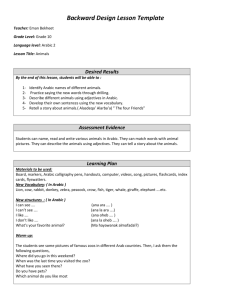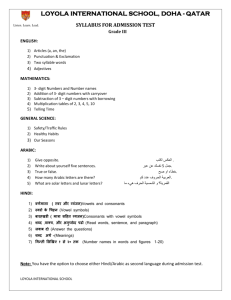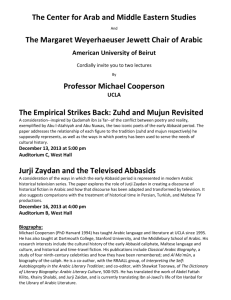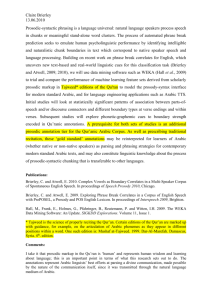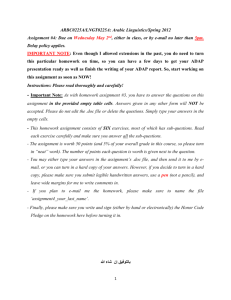classroom objects lesson plan
advertisement
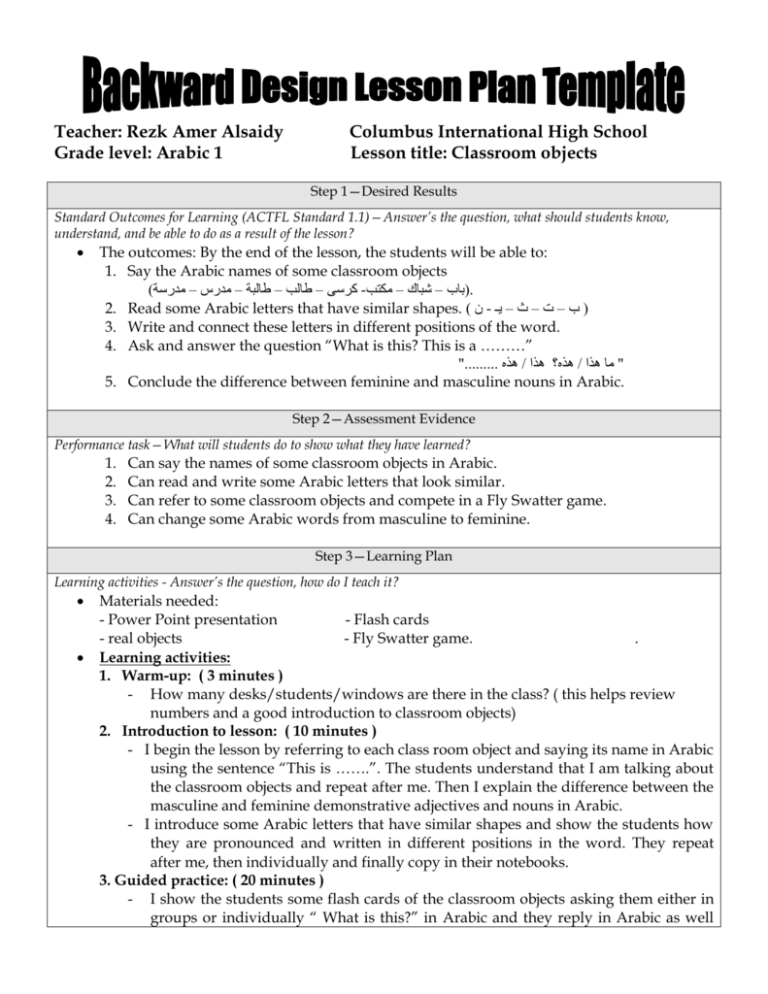
Teacher: Rezk Amer Alsaidy Grade level: Arabic 1 Columbus International High School Lesson title: Classroom objects Step 1—Desired Results Standard Outcomes for Learning (ACTFL Standard 1.1)—Answer’s the question, what should students know, understand, and be able to do as a result of the lesson? The outcomes: By the end of the lesson, the students will be able to: 1. Say the Arabic names of some classroom objects ) كرسى – طالب – طالبة – مدرس – مدرسة-(باب – شباك – مكتب. 2. Read some Arabic letters that have similar shapes. ) ن- ( ب – ت – ث – يـ 3. Write and connect these letters in different positions of the word. 4. Ask and answer the question “What is this? This is a ………” "......... هذه/ هذه؟ هذا/ " ما هذا 5. Conclude the difference between feminine and masculine nouns in Arabic. Step 2—Assessment Evidence Performance task—What will students do to show what they have learned? 1. 2. 3. 4. Can say the names of some classroom objects in Arabic. Can read and write some Arabic letters that look similar. Can refer to some classroom objects and compete in a Fly Swatter game. Can change some Arabic words from masculine to feminine. Step 3—Learning Plan Learning activities - Answer’s the question, how do I teach it? Materials needed: - Power Point presentation - Flash cards - real objects - Fly Swatter game. . Learning activities: 1. Warm-up: ( 3 minutes ) - How many desks/students/windows are there in the class? ( this helps review numbers and a good introduction to classroom objects) 2. Introduction to lesson: ( 10 minutes ) - I begin the lesson by referring to each class room object and saying its name in Arabic using the sentence “This is …….”. The students understand that I am talking about the classroom objects and repeat after me. Then I explain the difference between the masculine and feminine demonstrative adjectives and nouns in Arabic. - I introduce some Arabic letters that have similar shapes and show the students how they are pronounced and written in different positions in the word. They repeat after me, then individually and finally copy in their notebooks. 3. Guided practice: ( 20 minutes ) - I show the students some flash cards of the classroom objects asking them either in groups or individually “ What is this?” in Arabic and they reply in Arabic as well saying “This is ………”. - I give out the flash cards to the students asking them to work in pairs. One asks “What is this?” and the other answers “This is …….” Confirming on the masculine and feminine forms. I go round for helping. - To make sure they understand, I say each Arabic classroom object aloud in Arabic and they raise the card or refer to the object saying its Arabic name Again. - I give the students handouts that have the Arabic letters with their different shapes asking them to fill in the spaces as shown in the example. I go round for helping. Finally, I could call some individuals to come to the board and write different letters. 4. Review: ( 8 minutes ) - A Fly Swatter game. Two students compete together. I say the classroom object and the fastest to touch it is a winner. Next each student asks his pair “What is this?” and the other answers, then they exchange rules. 5. Closure/ extension: ( 4 minutes ) - I point to the names of the classroom objects they have studied and say a complete sentence “This is ………” and the students repeat after me. Step 4—Reflection What happened during my lesson? What did my students learn? How do I know? What did I learn? How will I improve my lesson next time? - The lesson went on very well and most of the students could say the Arabic names of the classroom objects (8 objects) and the five Arabic letters. They could ask and answer each other. Over the next days, I am going to teach them Arabic names of the other classroom objects and another group of letters. ) قلم جاف – قلم رصاص – قلم سبورة – براية – ممحاة – مسطرة- كتاب – دفتر – سبورة – ترابيزة – حقيبة- (فصل )( ج – ح – خ Adapted from Tomlinson and McTighe, Integrating Differentiated Instruction + Understanding by Design, ASCD,


